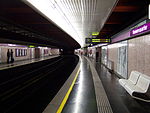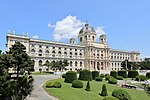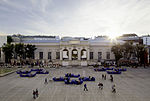Kunsthistorisches Museum

The Kunsthistorisches Museum (lit. "Museum of Art History", often referred to as the "Museum of Fine Arts") is an art museum in Vienna, Austria. Housed in its festive palatial building on the Vienna Ring Road, it is crowned with an octagonal dome. The term Kunsthistorisches Museum applies to both the institution and the main building. It is the largest art museum in the country and one of the most important museums worldwide. Emperor Franz Joseph I of Austria-Hungary opened the facility around 1891 at the same time as the Natural History Museum, Vienna which has a similar design and is directly across Maria-Theresien-Platz. The two buildings were constructed between 1871 and 1891 according to plans by Gottfried Semper and Baron Karl von Hasenauer. The emperor commissioned the two Ringstraße museums to create a suitable home for the Habsburgs' formidable art collection and to make it accessible to the general public. The buildings are rectangular, with symmetrical Renaissance Revival façades of sandstone lined with large arched windows on the main levels and topped with an octagonal dome 60 metres (200 ft) high. The interiors of the museums are lavishly decorated with marble, stucco ornamentation, gold-leaf, and murals. The grand stairway features paintings by Gustav Klimt, Ernst Klimt, Franz Matsch, Hans Makart and Mihály Munkácsy.
Excerpt from the Wikipedia article Kunsthistorisches Museum (License: CC BY-SA 3.0, Authors, Images).Kunsthistorisches Museum
Burgring, Vienna Innere Stadt
Geographical coordinates (GPS) Address Phone number Website External links Nearby Places Show on map
Geographical coordinates (GPS)
| Latitude | Longitude |
|---|---|
| N 48.203801944444 ° | E 16.361786944444 ° |
Address
Kunsthistorisches Museum
Burgring 5
1010 Vienna, Innere Stadt
Austria
Open on Google Maps










